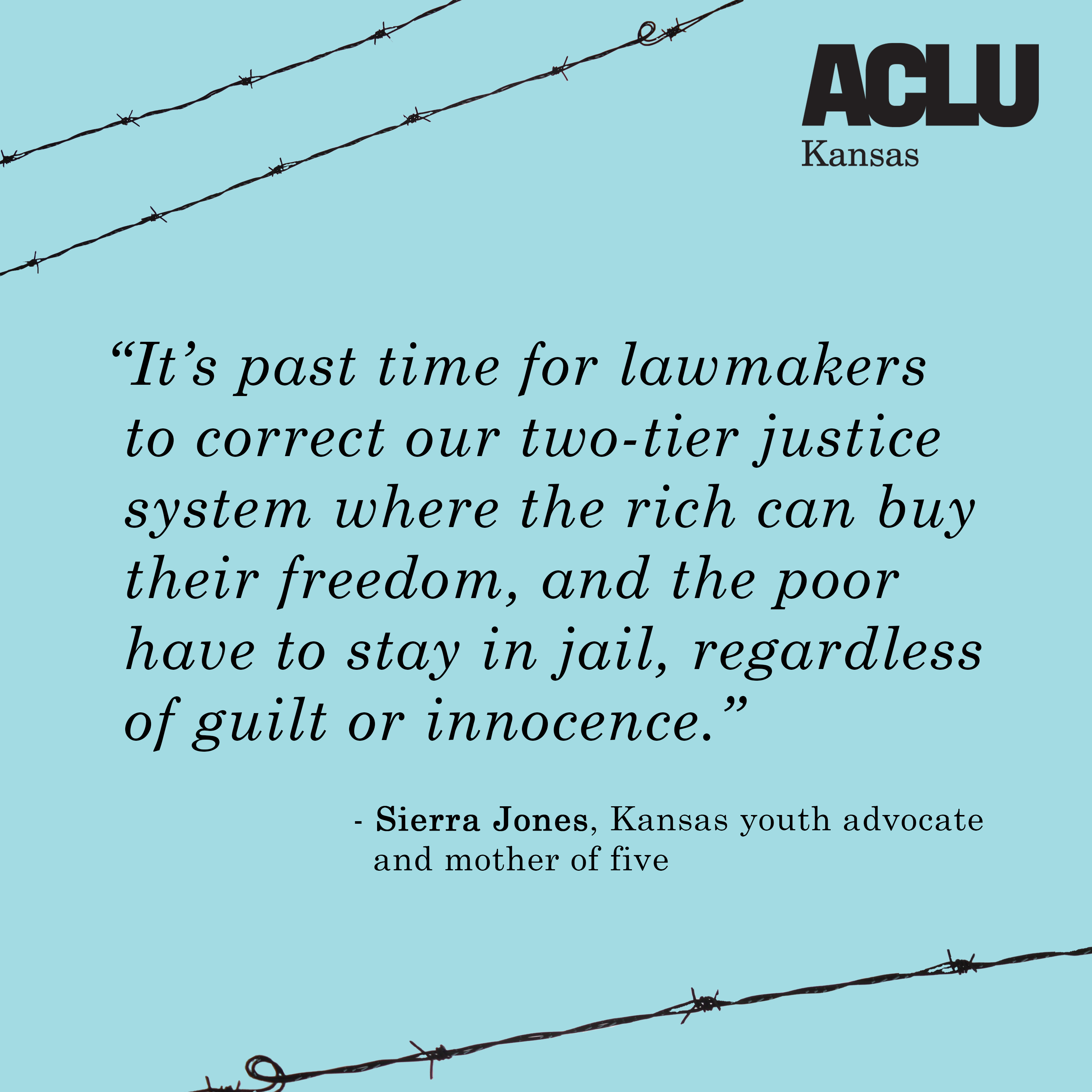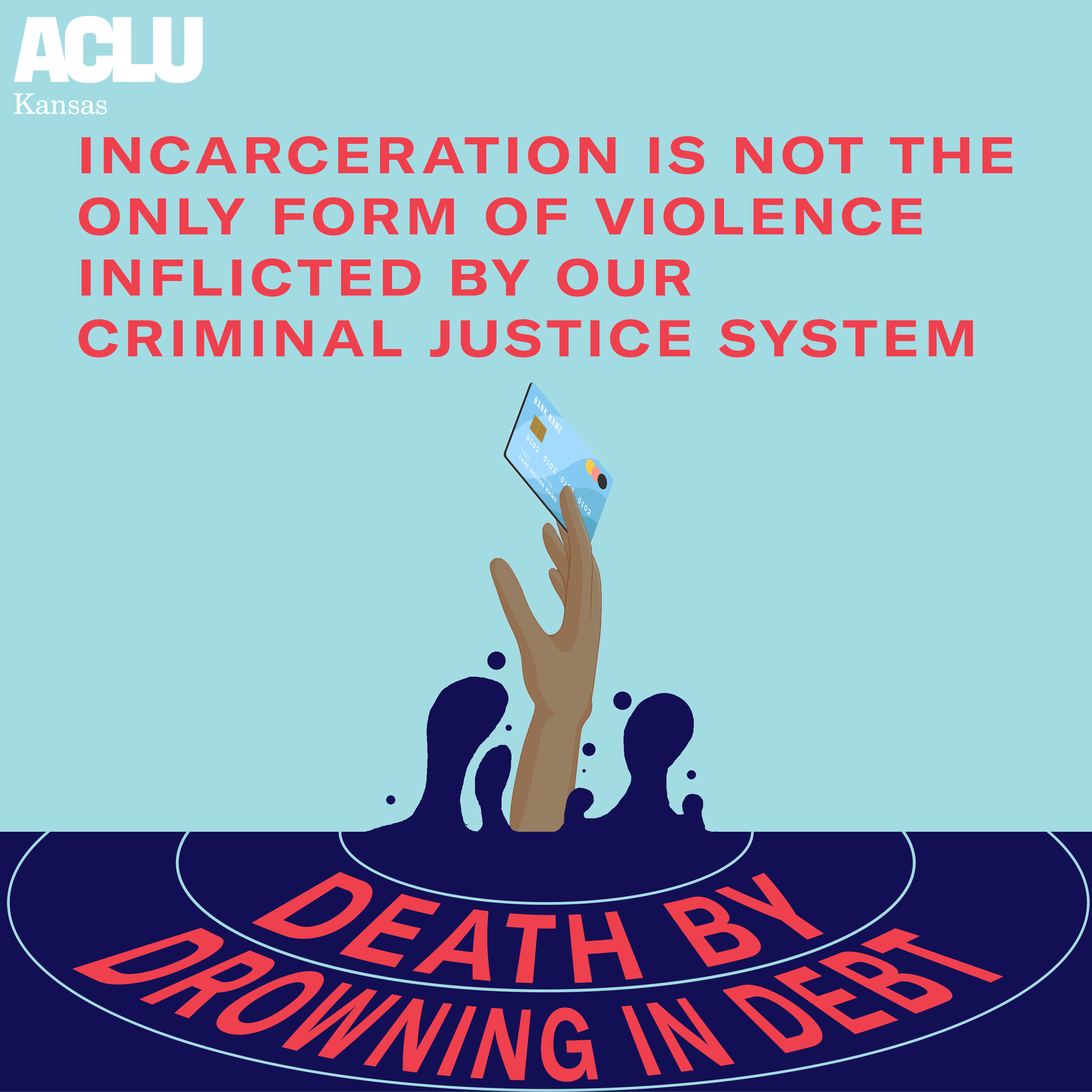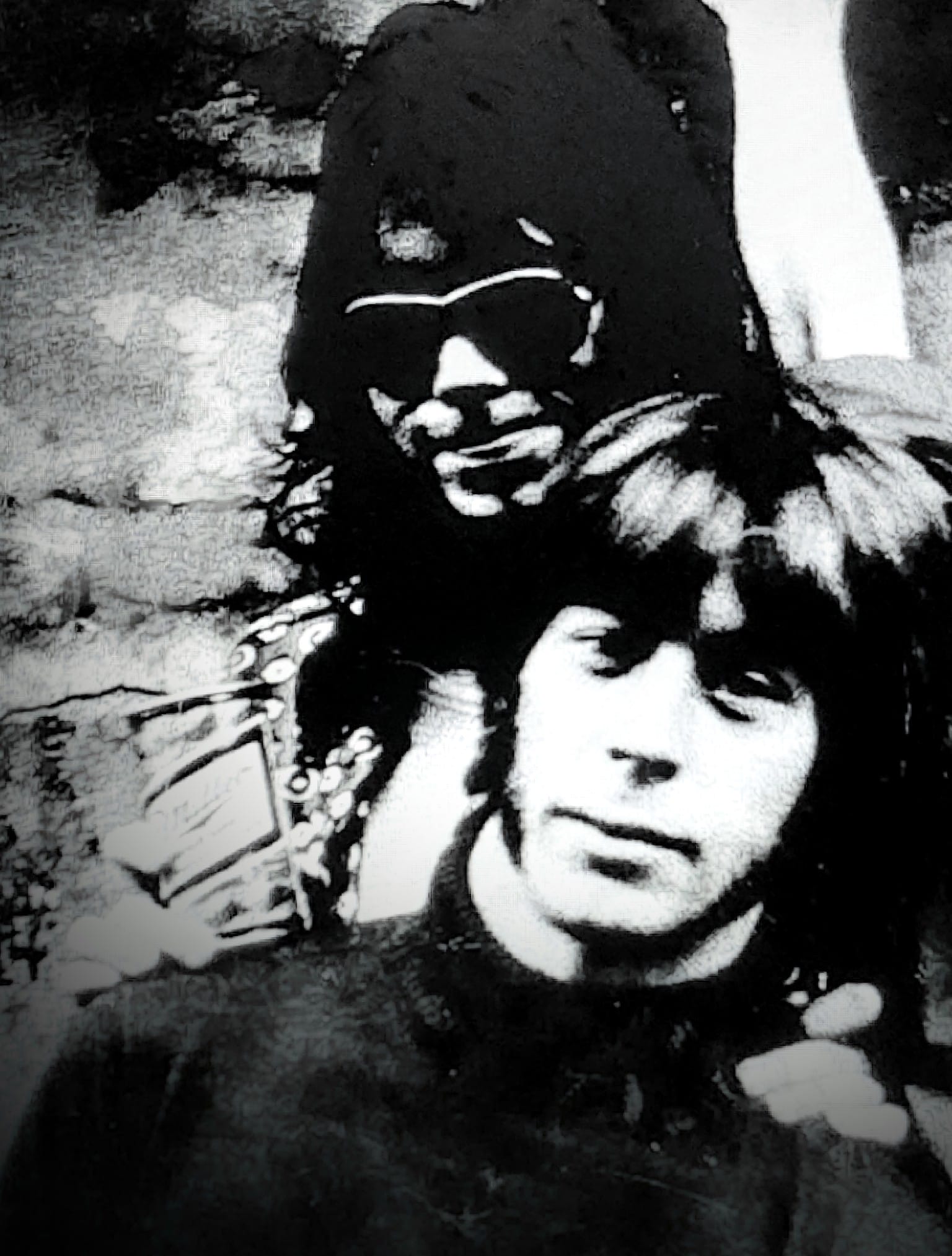I’m a youth advocate for children in the welfare system and a mother of five, and I have also navigated the adult justice system. I know from personal experience how our current bail system in Kansas criminalizes poverty – I was given a one-million dollar bond for six months on a probation violation for misdemeanor theft.
It’s past time for lawmakers to correct our two-tier justice system where the rich can buy their freedom, and the poor have to stay in jail, regardless of guilt or innocence.
Sheriff Easter recently commented on bail reform that, “When we’re talking about reform, we need to be very cognizant about what that reform means. If there’s absolute differences on a misdemeanor bond that someone who had money so their bonds set at this—which they can make—[for] someone else who doesn’t have money, a bond was set they couldn’t make. Maybe we need to take a look at that.” He also repeated the that he is highly against some of the reforms coming from both coasts that allow violent offenders to get out more easily.
Sheriff Easter’s comment also shows he doesn’t realize that when we talk about bail reform, we’re not making broad statements about all offenders. Judges and prosecutors will still have the ability to use their power have concrete options if someone is truly a safety concern or flight risk.
Sheriff Easter and I don’t disagree that we should set higher bonds for more serious crimes, or that we should be considerate of community safety. But I can recall numerous examples of people charged with murder and more severe crimes who had lower bond amounts set than I did.
Most of the crimes we are referring to in this conversation about bail reform hold little jail time as it is—so many of these people will be back into the community at some point anyway. They will likely be far worse off than they were before and more likely to commit more crimes after a lengthy stay in jail that disrupts their lives by interfering with employment, family relationships, housing, and more.
I hope the sheriff will see the reality of how our current bail system has affected people in our community, including me, and how it’s failing to meet the goals for public safety that he has, too. My own experience demonstrates the reality that bonds are not, in fact, affordable for many of us who pose no safety risk or flight risk.
Current laws state that bail should be set at a rate that is affordable to each individual. Currently judges set bonds with no guidelines to go off of besides how they feel that day or how they view the crime committed, and a new bill that recently passed the legislature actually now requires a 10% minimum payment.
I am asking community leaders to take a look at what bonds are being set and compare each individual based off of their crimes and see if they agree with the way it sits currently. All you need do is go to Sedgwick County’s web site, search inmates, and you can see that something needs to be done. I ask that we adopt a policy of mandated pretrial release for less dangerous crimes rather than detention because detaining someone not only is a burden on the community, but many people end up losing homes, jobs, and children while sitting in jail on petty crimes.
Our current bail system fails to rehabilitate, and contradicts our values that a person is innocent until proven guilty.
Our community in Sedgwick County is asking for change because we see a need to stop punishing people simply for being poor – and we hope the Sheriff will meet us at the table.
-Sierra Jones
Date
Tuesday, July 16, 2024 - 2:30pm
Featured image
Show featured image
Hide banner image
Show related content
Tweet Text
[node:title]
Type
Menu parent dynamic listing
Show PDF in viewer on page
Style
Standard with sidebar
Show list numbers
Kansas imprisons fewer juveniles than ever before, but sharp racial disparities stubbornly persist.
This odyssey – where the juvenile justice corrections system selects and collects youth in facilities -- eventually will figuratively incarcerate youth in smothering debt. But first, it incarcerates them literally. Kansas children and young adults as well as their families pay a host of fees derived from their stays in prisons, from their court dates, from their urinalysis lab fees, penalties for nonpayment, restitution to victims, late fees, calculated interest, and more.
There’s bad news, as well as some progress.
Kansas corrections officials tout reductions in juvenile incarceration following legislative reform efforts but continue to confront ugly racial disparities. According to a 2019 report from the Kansas Department of Corrections, the state has seen a 24 percent decline in the number of incarcerated youths in the aftermath of legislative reforms. In fact, the state closed one of the two youth prisons in the state.
Despite those gains, however, the report said racial disparities persist. In 2018, according to the report, Black youth were three times more likely than white youth to be arrested, nearly six times more likely to be detained, and more than seven times more likely to be “detained in secure confinement.”
Asked about those disparities, Department of Corrections Spokesman David Thompson said the answer to that conundrum could only be found upstream from prisons.
“We believe this question would be more appropriately answered by the state’s prosecutors and court system than of the Kansas Department of Corrections,” Thompson said in an email exchange.
Thompson said the DOC envisions helping all youth committed to its custody, including youth of color, receive the education, programming, and/or treatment necessary to equip them to be successful on their return to their communities.
State corrections officials have called for still more reform, according to the report.
“To reduce these disparities, Kansans United for Youth Justice recommends that Kansas law enforcement and youth corrections agencies partner with justice-involved youth and their families to guide reform; revise laws and policies to address the disparate racial impact; develop accountability and compliance mechanisms for law enforcement, and incorporate implicit bias training for law enforcement, court services, judges, jurors, and all those involved with the juvenile justice system.”
As the numbers here in Kansas suggest, young, Black males garner more than their share of attention for behaviors excused for youth who are white.
This happens everywhere Black children exist.
Some youth will arrive at facilities with a fair amount of debt from hearings and court appearances, and any time spent on probation, but they get more helpings of debt heaped on them once entering. They will leave those institutions imprisoned by still more unwieldy debt. And because of those racial disparities, the youth of color who could least afford any additional debt, seem to have the most debt stacked on top of them.
This level of incarceration isn’t cheap, and the network of fines and fees were ostensibly meant to help offset those costs.
Kansas spends $134,000 a year for each youth at the Kansas Juvenile Correction Complex in Topeka. That’s essentially $368 a day, per youth.
On any given day nation-wide, nearly 60,000 youth under age 18 are incarcerated in juvenile jails and prisons in the United States. These rates vary widely. But in every state, confining young people – cutting them off from their families, disrupting their educations, and often exposing them to further trauma and violence – harms their development and has lifelong negative consequences.
Our system for dealing with juvenile crime remains beset by many of the same issues that exist in the adult system including but not limited to sexual abuse, criminal activity, punishment isolation and much more. Our system seems heavily calibrated for punishment rather than restorative rehabilitation.
Youth in juvenile facilities may suffer from substance abuse, mental illness, sexual abuse but the system seems to respond only to criminality and not to the trauma that may have triggered such behavior. “There’s a proven link between abuse and neglect of children in cases of juvenile delinquency,” said the website, Lawinfo.com
We shackle children in our system, sometimes at their wrists, their waists, their ankles. They get strip searched. They endure physical attacks from other residents as well as from guards. But we seem mystified that problems inside our system persist.
Those 2016 reforms – reforms undertaken at the legislative level that lowered the number of youths in state custody – wrought some welcomed results.
For example, Kansas has significantly reduced youth incarceration for technical violations. In 2019, only five percent of new incarceration admissions were for technical violations. In 2015, 68 percent of youth admissions were for technical violations.
Also, the report said that the number of youths incarcerated in juvenile correction facilities in Kansas declined by 52 percent between 2010 and 2019. During this same period, the number of youths in juvenile custody (out-of-home placements, foster care, home treatment, psychiatric residential treatment centers, etc.) dropped 88 percent. Also, the number of youths on intensive probation declined 49 percent.
“Kansas has worked to align our juvenile justice system with evidence-based practices for justice-involved youth,” Thompson said. “As a state, we are reinvesting more resources in communities to divert youth from deeper system involvement.”
But while some of the numbers trended in a good direction, some of the figures inside these numbers represent a cause for alarm.
In 2019, for example, 52 percent of youth “prioritized for incarceration” were assessed as “high risk.” In 2013, 99 percent of youth admitted to JCFs were assessed as low or moderate risk. In 2019, 48 percent were assessed as low or moderate risk.
Also of concern, by 2019, 45 percent of assessed youth admitted to JCFs were assessed as “Behavioral Health Level 3 or requiring an individualized treatment plan involving mental health contacts at least monthly. No youths were assessed as Behavioral Health Level 4, which would indicate a serious disorder.
Now that we’ve seen just how effective reforms can be, we must envision and build a system that better serves youth, their families and helps them return to their communities to be better able to navigate society.
Date
Wednesday, July 10, 2024 - 12:15pm
Featured image
Show featured image
Hide banner image
Show related content
Tweet Text
[node:title]
Type
Menu parent dynamic listing
Show PDF in viewer on page
Style
Standard with sidebar
Show list numbers
Tom Ellis has worn a variety of hats in his lifetime from big city rockstar to Kansas artist (his autobiographical one-man exhibit opened 3 years ago in Chanute). After growing up on a Kansas farm, Tom went to the Kansas City Art Institute to study his first love, visual arts, and then went to Pittsburg State college to major in voice and minor in art. Post college, Tom headed to New York with three introductions in his pocket: Picnic author Thomas Inge, the secretary to poet Allen Grossman, and actor Dean Dittman. Tom went on to develop relations with Stephen Schwartz, the creator of ‘Wicked’, and Tom’s band, ‘Molimo’, hired Ace Frehley as their lead guitarist – who would later go on to form KISS.
Little did Tom know that he would take part in one of our nation’s most historic events, simply by visiting his local bar. For the next year or two, Tom visited Stonewall as a "young, gay man on the prowl," and reveled in the hedonistic aura of New York City in the late 1960's. On the anniversary of Stonewall, we sat down with this unique Kansan who was there.
Tom: “I was there the night before. And I saw the police outside and knew something was up so I stayed outside. Saw the commotion...”
June 28th, 1969 was just the beginning of a series of events we know today as the Stonewall Riots. But before the riots, there was just Stonewall.
Q: “Can you speak a little bit more on the culture that was Stonewall. A lot of people just know about [the Stonewall riots,] they don’t know [about the] community [engagement].”
Tom: “The Stonewall was the local bar for me, I used to live in the Village. It used to be a great dance place, along with being a pick-up bar and a bar bar… [Stonewall] was on a little street called Christopher St. Doesn’t get an awful lot of traffic. It’s a little narrow street. I think it’s a one-way, pretty sure. So, when you see a couple of trucks pull up to Stonewall… paddy wagons, you know something’s up. It was a habit for police to come often to bars like Stonewall, where gay men congregated, and harass the customers if the bar didn't pay protection money. This was very serious because when arrests were made, your name was published in the paper. You could lose your job, your marriage, your family, your life. It was bad times for gays at that point.”
Tom's husband Bob, New York's Commissioner of Human Rights at the time, was one such victim of anti-gay sentiment. After being outed in an interview with the New York Times, being rejected by his mother as a result, and learning of his husband's experiences at Stonewall, Bob was activated to mobilize. "He agreed it was time for the 2% of Americans who were gay, to have equal rights, and that it was not gonna be easy," said Tom. Together, Bob and Tom founded the National Gay Taskforce (now National LGBTQ Task Force) along with Dr. Howard Brown, New York City’s openly gay Surgeon General. Kansan involvement in historical precedents is not unique, (Bleeding Kansas, the Free State, and our recent historical decision to protect abortion), but Tom Ellis is.
Q: “There’s this idea behind Stonewall that it was just one person throwing a brick, and that was it… do you want to do any clarifying on what that scene was?”
Tom: “Well there was no community at that point. It was a bunch of young guys who were having sex, ya know. First of all, this was the time of free love, before AIDS, and it was unbelievably exciting. Just unimaginably hedonistic. And the dancing was great, the music was fabulous… everything just came together to make a beautiful era, unique in American history. And I had nothing, I was poor. I had a job at Bloomingdales, working the display department. Not making much money, but feeling happy and free, and paying $65 a month for 6 floor walkup.”
The thriving LGBTQ community we know today wasn’t always that way. In fact, for Tom at the time, it was just him, his guitar, and the guys he met at bars and on the streets.
Tom: “The next day after the riots, I took my guitar down to the Stonewall and I sat on the steps and I started playing folk music and civil rights songs. And I had gathered about maybe 10 people, and we were just listening to me sing. Because the sidewalk was so small some of them were spilling out onto the street. And the police drove by and very courteously said, ‘move on, please, this is not a place to congregate.’ So we all just moved on and I must say the police seemed very polite at that point. The day after that, I don’t know how it happened, but someone spread word there was a gathering in Washington square beneath the arc de triumph. About 40 guys set and listened to various guys talk about our rights to be free from harassment by the police. We talked for about half an hour and someone said 'let's march up 5th avenue and talk to the mayor,' people thought, 'well it's a long ways but he should hear about this,' 'let's confront the police,' and all that so we start at fifth avenue. We didn’t have any, you know, passes or permits or anything like that, we just started marching up fifth avenue which is a one-way street going down. We stopped traffic all the way. I don’t know how far we got… I’m thinking like 20 to 25 blocks. You know, we kind of had an interesting movement going there for a while. And I don’t know if any one of us had placards or signs, and the people in cars were pretty mystified as to who these people were and what they were angry about. I don’t even know if it made the papers.”
Today, our country remembers America’s first gay pride parade as the 1970 Christopher Street Liberation Day where thousands of protestors marched from Stonewall Inn to Central Park. Little do many know of the smaller parade the year before, that started with some songs played on a guitar by Kansan Tom Ellis.
While our history books may not acknowledge the smaller events that culminate into massive movements, this individual Kansan was absolutely integral in the larger puzzle of progress and our story for liberation.
Today, Tom lives in Iola, on the land he grew up on, creating art, occasionally singing, and working on an autobiography of his life story. Tom exemplifies that LGBTQ Kansans are not just living in Kansas, they are thriving and still making history.
Date
Friday, June 28, 2024 - 2:00pm
Featured image
Show featured image
Hide banner image
Show related content
Tweet Text
[node:title]
Type
Menu parent dynamic listing
Show PDF in viewer on page
Style
Standard with sidebar
Show list numbers
Author
Alina Matejkowski
Pages


